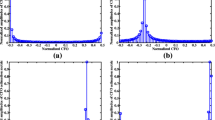Abstract
One of the major challenges in orthogonal frequency division multiplexing system is its high peak-to-average-power ratio (PAPR). Among the existing PAPR reduction technologies, clipping is the most often used one due to its simplicity of implementation. But it induces signal distortion. In this paper, we propose a new PAPR reduction method which introduces compressive sensing theory to help the clipping and signal recovery processes. Our method has superior symbol-error-rate (SER) performance compared with traditional clipping, and at the same time has better PAPR reduction performance compared with traditional tone reservation based algorithms. What is more, different from the existing high-complexity compressive sensing based scheme which tries to solve an optimization problem, the proposed algorithm uses orthogonal matching pursuit scheme to recover the distorted signals, thereby it significantly reduces the computational complexity with the same PAPR reduction efficiency. Simulation results show that our proposed scheme can achieve dramatic PAPR reduction with only about \(10\,\%\) of the existing method, while still keeps good SER performance.





Similar content being viewed by others
References
Weinstein, S. B., & Ebert, P. M. (1971). Data transmission by frequency division multiplexing using the discrete Fourier transform. IEEE Transactions on Communications, 19, 628–634.
Cimini, L. J, Jr. (1985). Analysis and simulation of a digital mobile chaneel using orthogonal frequency division multiplexing. IEEE Transactions on Communications, 33, 665–675.
Han, S. H., & Lee, J. H. (2005). An overview of peak-to-average power ratio reduction techniques for multicarrier transmission. IEEE Wireless Communications, 12(2), 56–65.
Bae, K., Andrews, J. G., & Powers, E. J. (2010). Adaptive active constellation extension algorithm for peak-to-average ratio reduction in OFDM. IEEE Communications Letters, 14(1), 39–41.
Tellado, J. (2000). Multicarrier modulation with low PAR—applicaiton to DSL and wireless. Dordrecht: Kulwer Academic Publication.
Mahafeno, I. M., Louet, Y., & Helard, J.-F. (2009). Peak-to-average power ration reduction using second order cone programming based tine reservation for terrestrial digital video broadcasting systems. IET Communications, 3(7), 1250–1261.
Krongold, B. S., & Jones, D. L. (2004). An active-set approach for OFDM PAR reduction via tone reservation. IEEE Transactions on Signal Processing, 52(2), 495–509.
Wang, M., Quevedo, D. E., Goodwins, G. C., & Krongold, B. S. (2008). A complex-baseband active-set approach for tone reservation PAR reduction in OFDM systems (pp. 113–117). AusCTW: Communications Theory Workshop.
Liang, Q., Wen, Q., Xiao, Y., & Li, S. (2009). A comparison of SCR and active-set methods for PAPR reduction in OFDM systems. In Proceedings of the international conference on networks, Security (pp. 489–495).
Jung-Chieh, C., & Chih-Peng, L. (2010). Tone reservation using near-optimal peak reduction tone set selection algorithm for PAPR reduction in OFDM systems. IEEE signal Processing Letters, 17(11), 933–936.
Baraniuk, R. G. (2007). Compressive sensing. IEEE Signal Processing Magazine, 24, 118–124.
Tropp, J., & Gilbert, A. (2007). Signal recovery from random measurements via orthogonal matching pursuit. IEEE Transactions on Information Theory, 53, 4655–4666.
Chen, S., Donoho, D., & Saunders, M. (1998). Atomic decomposition by basis pursuit. SIAM Journal on Scientific Computing, 20(1), 33–61.
Donoho, D., & Tanner, J. (2005). Neighborliness of randomly projected simplicies in high dimensions. Preprint.
Al-Safadi, E. B., & Al-Naffouri, T. Y. (2009). On resducing the complexity of tone reservation based PAPR reduction schemes by compressive sensing. In Proceedings of the IEEE Globecom 2009. Honolulu HI.
Grant, M., Boyd, S. (2009). CVX: Matlab software for disciplined convex programming (web page and software). http://stanford.edu/boyd/cvx. Feb 2009.
Author information
Authors and Affiliations
Corresponding author
Additional information
This work was supported by National Natural Science Foundation of China (61221001, 61201222, 61302093, 61362013), the 111 Project (B07022) and the Shanghai Key Laboratory of Digital Media Processing and Transmissions. It is also partly supported by the open research fund of National Mobile Communications Research Laboratory, Southeast University (2013D07)
Rights and permissions
About this article
Cite this article
Liu, B., Liu, S., Rui, Y. et al. A Low-Complexity Compressive Sensing Algorithm for PAPR Reduction. Wireless Pers Commun 78, 283–295 (2014). https://doi.org/10.1007/s11277-014-1753-8
Published:
Issue Date:
DOI: https://doi.org/10.1007/s11277-014-1753-8




